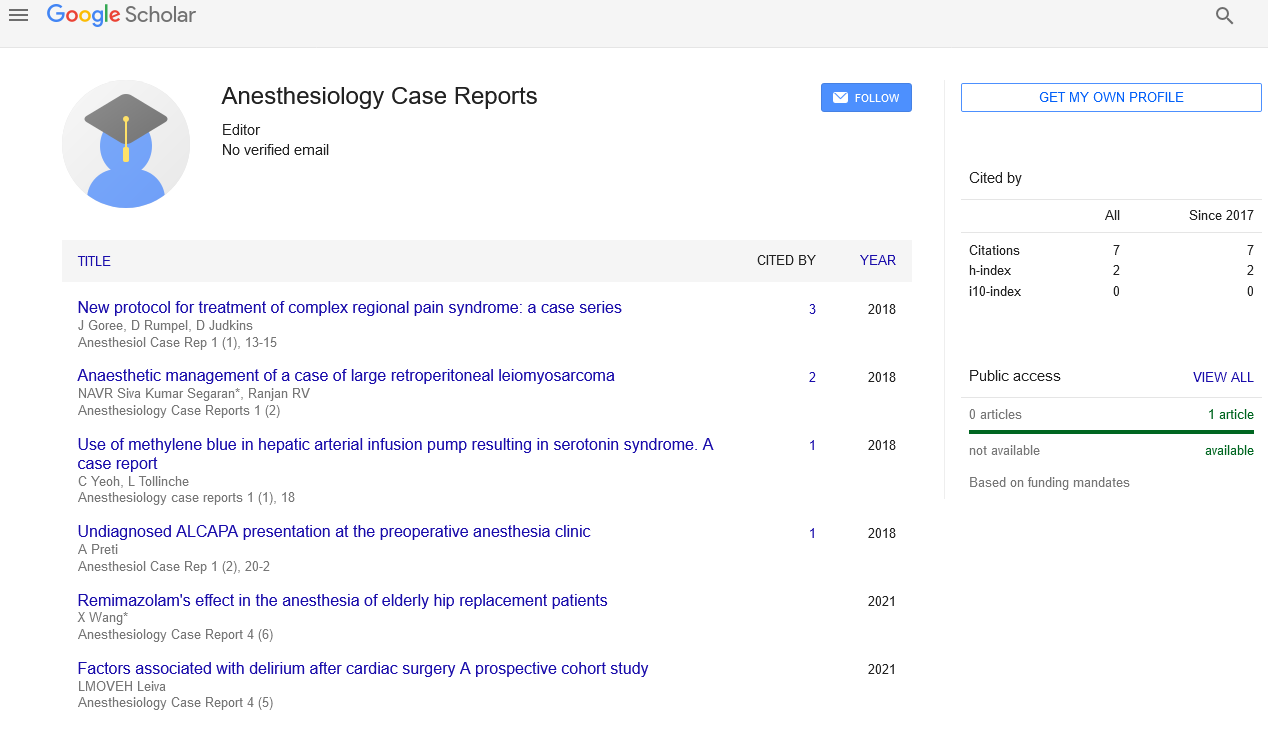Anesthesiology Clinical Trials
Received: 15-Mar-2023, Manuscript No. PULACR-23-6458 ; Editor assigned: 20-Mar-2023, Pre QC No. PULACR-23-6458 (PQ); Accepted Date: Apr 05, 2023; Reviewed: 30-Mar-2023 QC No. PULACR-23-6458 (Q); Revised: 03-Apr-2023, Manuscript No. PULACR-23-6458 (R); Published: 11-Apr-2023
Citation: Pandey A. Anesthesiology Clinical Trials. Anesthesiol Case Rep. 2023; 6(2)17
This open-access article is distributed under the terms of the Creative Commons Attribution Non-Commercial License (CC BY-NC) (http://creativecommons.org/licenses/by-nc/4.0/), which permits reuse, distribution and reproduction of the article, provided that the original work is properly cited and the reuse is restricted to noncommercial purposes. For commercial reuse, contact reprints@pulsus.com
Abstract
Anesthesia or anaesthesia (from Greek “without sensation”) is a state of controlled, temporary loss of sensation or awareness that is induced for medical purposes. It may include some or all of analgesia (relief from or prevention of pain), paralysis (muscle relaxation), amnesia (loss of memory), and unconsciousness. A patient under the effects of anesthetic drugs is referred to as being anesthetized. In preparing for a medical procedure, the clinician chooses one or more drugs to achieve the types and degree of anesthesia characteristics appropriate for the type of procedure and the particular patient. The types of drugs used include general anesthetics, local anesthetics, hypnotics, dissociatives, sedatives, adjuncts, neuromuscular-blocking drugs, narcotics, and analgesics.
Introduction
Anesthesia or anaesthesia (from Greek “without sensation”) is a state of controlled, temporary loss of sensation or awareness that is induced for medical purposes. It may include some or all of analgesia (relief from or prevention of pain), paralysis (muscle relaxation), amnesia (loss of memory), and unconsciousness. A patient under the effects of anesthetic drugs is referred to as being anesthetized.
In preparing for a medical procedure, the clinician chooses one or more drugs to achieve the types and degree of anesthesia characteristics appropriate for the type of procedure and the particular patient. The types of drugs used include general anesthetics, local anesthetics, hypnotics, dissociatives, sedatives, adjuncts, neuromuscular-blocking drugs, narcotics, and analgesics.
On behalf of the Board of the Anesthesiology Case Reports and my co- editors, I am glad to present the Volume 6, Issue 2 of the journal. The journal established in the year 2018 has now published is 6 Volumes; 6 issues in a year. Average download per article is increasing and on an average there are 20 downloads per paper. All these are promising signs. We could reach this stage through the constant support of Board Members and intellectual generosity of the readers and contributors (authors and reviewers)[1-2].
We also feel that a need exists for additional facilities for the publication of the Clinical and Experimental trials in anesthesia and anesthesiology research, especially in their relation to medical and clinical sciences. Therefore, it has been resolved that papers on these topics will be welcome in our Journal; and in order to accentuate the importance we attribute to the cultivation of Anesthesia and Analgesia.
Anesthesiology Case Reports is a peer-reviewed journal in which helps in uplifting the different case reports, research studies in the field of anesthesia. Our journal contributes various case reports, case studies, research work throughout the global wise. Our journal is the perfect platform to showcase the different types of case reports all over the world as we encourage every doctor, eminent authors, students, graduates etc., from any part of the world[3-4].
Now, we are going to release an Issue 2 in the volume 6. With the support of the eminent authors around the world, we our editorial members feel privileged to showcase the different case reports and studies. As always, we would like to thank our steadfast faculty advisors. Their guidance and support make our journal possible, and we are deeply indebted to them for the time and effort that they put into our journal. On a final note, the outgoing board would like to send its best wishes to next year’s new board members[4-5].. We hope that the incoming board will strive to honor the efforts of the past ten years and pass down the work ethic and appreciation of academic scholarship to future ACR members.
References
- Ahmad F, Silva EL, Varesche MB. Hydrothermal processing of biomass for anaerobic digestion–a review. Renew. Sustain. Energy Rev. 2018;98:108-24.
- Al-Ashouri A, Köhnen E, Li B, et al. Monolithic perovskite/silicon tandem solar cell with> 29% efficiency by enhanced hole extraction. Science. 2020;370(6522):1300-9.
- Aruna-Devi R, Marasamy L, Cruz-Gómez J, et al. Exploring the performance of hybrid solar cells based on organic polymers/inorganic CdS nanostructures. Mater. Lett. 2021;282:128856.
- Bach QV, Sillero MV, Tran KQ, et al. Fast hydrothermal liquefaction of a Norwegian macro-alga: screening tests. Algal Res. 2014;6:271-6.
- Baek SW, Jun S, Kim B, et al. Efficient hybrid colloidal quantum dot/organic solar cells mediated by near-infrared sensitizing small molecules. Nat. Energy. 2019;4(11):969-76.





